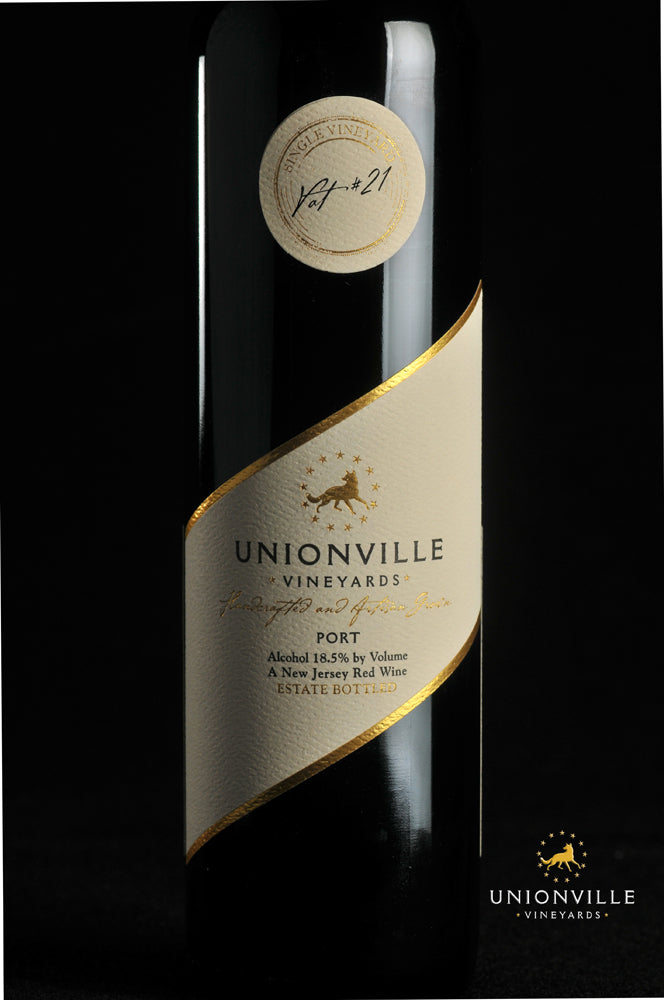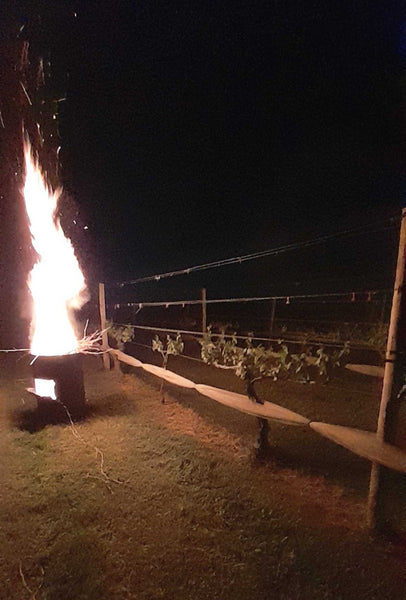Winter is coming and so is Port wine

It’s the most wonderful time of the year! I know that is cliché to say, but it truly is a great time at Unionville. We’ve got all of our reds pressed and in barrel. Cooler, stainless-steel fermentations are finishing up in tank, I’m finally able to breathe a little easier, and wake up a little later. With the holidays upon us, the wine making team has a lot on the mind, but one thing standing out is the blending, bottling, and release of Vat #23 – the latest rendition of our opulent Port wine.
Port has a storied history at Unionville – the fortified delight has been made at the winery since its first vintage in 1993, Before we delve into that, we have to talk a little about how Port is made and the different styles in which it can be presented.
Port, named for its origin country, Portugal, is typically a sweet or medium-dry red wine, fortified with distilled grape spirit, then cellared and bottled at different times and in different ways to present specific stylizations. The two most recognizable presentations of Port wine are Ruby and Tawny Ports. Ruby styles are young wines usually aged for only a couple of years (or less). They’re released early to showcase juicy acidity and fruity characteristics of young wine with fuller mouth feel and complexity coming from fortification. Tawny Ports are usually much older – benefitting from years of slow oxygen absorption and evaporation provided by the wooden barrels used for storing the wine. This oxidation promotes the development of the complexities and savory flavors of Port that we all know and love.
At Unionville, we started by making only vintage ports. Occasionally we still do, when special vintages are showcasing a specific style well. For the past 15 years however, Unionville has adopted a Solera-style blending technique (typically used for Sherries) to create our ”Vat Series”. This means we blend our Port across vintages to integrate aspects of multiple  harvests, styles, flavors, and structures. For example, Vat #23 is a carefully crafted blend of Port from nine vintages stretching from 2016 all the way back to 2001. Bright raspberry entry rapidly evolves into sinful notes of warm blueberry compote and creamy milk chocolate. As the senses adjust, the layered nature of this complex blend begins to take form, with flavors of crème brulee, dark chocolate, coffee liqueur, and amaretto flooding the mid-palate. Smooth, velvety mouthfeel with supple tannic structure accentuates these layers as the finish unfolds into deep notes of toffee and hazelnut that last long after you swallow. It’s a perfect journey through 15 years of Port production at Unionville Vineyards.
harvests, styles, flavors, and structures. For example, Vat #23 is a carefully crafted blend of Port from nine vintages stretching from 2016 all the way back to 2001. Bright raspberry entry rapidly evolves into sinful notes of warm blueberry compote and creamy milk chocolate. As the senses adjust, the layered nature of this complex blend begins to take form, with flavors of crème brulee, dark chocolate, coffee liqueur, and amaretto flooding the mid-palate. Smooth, velvety mouthfeel with supple tannic structure accentuates these layers as the finish unfolds into deep notes of toffee and hazelnut that last long after you swallow. It’s a perfect journey through 15 years of Port production at Unionville Vineyards.
However, while Vat #23 may be smooth, establishing a portfolio of 15 years of Port vintages while trying to maintain balance and economic volumes throughout every blend is anything but! The problem is, we want to make as much Port as we can every year for everyone to enjoy, but every time we blend we also must be thinking logistically about Vats as far as five years in the future. It takes years for Port wine to develop the complexity and intensity of those flavors exhibited on the midpalate and finish of our Port, so every time we take 20 gallons out of a barrel, its 20 gallons of that specific profile away from next years’ Vat, and that of future editions as well. On top of this, vintages that we use for accentuating ruby flavors in Port, in time, will become the vintages we use for the memorable tawny finish.
Chambourcin (the bright and juicy French-American  hybrid grape we use to make our Port) is one of the only hybrids we grow and use consistently at Unionville, with most of our production focused on Vitis vinifera vines such as Chardonnay, Syrah, and Pinot Noir. Vinifera takes a lot more skill and effort to grow and maintain, so for a number of years, putting time, effort, and materials into controlling crop load and protecting Chambourcin from hungry predators like birds and deer took the backseat to doing the same for the rest of our crop. Unfortunately, this began to put huge amounts of pressure on our yearly Port production with sometimes as much as 75% of our Chambourcin crop being destroyed by harvest time.
hybrid grape we use to make our Port) is one of the only hybrids we grow and use consistently at Unionville, with most of our production focused on Vitis vinifera vines such as Chardonnay, Syrah, and Pinot Noir. Vinifera takes a lot more skill and effort to grow and maintain, so for a number of years, putting time, effort, and materials into controlling crop load and protecting Chambourcin from hungry predators like birds and deer took the backseat to doing the same for the rest of our crop. Unfortunately, this began to put huge amounts of pressure on our yearly Port production with sometimes as much as 75% of our Chambourcin crop being destroyed by harvest time.
Volume pressure throws yet another logistical variable into our blending practices making it difficult to either make a balanced Port or make enough of one, so in the past couple years, we have been focusing on adjusting our management practices as well as investing capital in assuring we get the most out of the 3.5 acres of Chambourcin we have planted. From 2015 to 2017 we have more than doubled our Port production, and will continue to invest in restoring these vineyards to their full potential in an effort to keep growing production and keep making unique, balanced, nuanced Port wine.
As Port is restored to its foundational position in our portfolio, we look towards the future knowing that when we only have ten gallons of the well-structured 2010 vintage, the 2013 vintage is our most balanced tawny to date, or the 2016 vintage’s youthful blueberry note has developed into a deep mocha flavor impossible to ignore, we will still be using all three and everything after and in between to master our November blend for your enjoyment.
Vat #23 as of mid-February is just about sold out. Click here to grab one of the last remaining bottles.
-Conor Quilty, Associate Winemaker
Leave a comment
Comments will be approved before showing up.
Also in Unionville Grapevine

The Best Wines are the Ones You Fight For
We picked from 5am that day until a little past midnight, almost 19 hours of harvesting. The pick was only interrupted for bathroom breaks, pizza, and eventually some beers to keep morale high. I think the high morale beer was Miller High Life, although the details are fuzzy and it would only have been selected ironically. It was the most tenacious day I can recall in the field here. We picked nearly 10 tons from three different vineyards, finishing with the Pheasant Hill Chardonnay. We saran wrapped the bins during transport and weighing back at the winery as Ophelia's first raindrops splashed down just after midnight.


